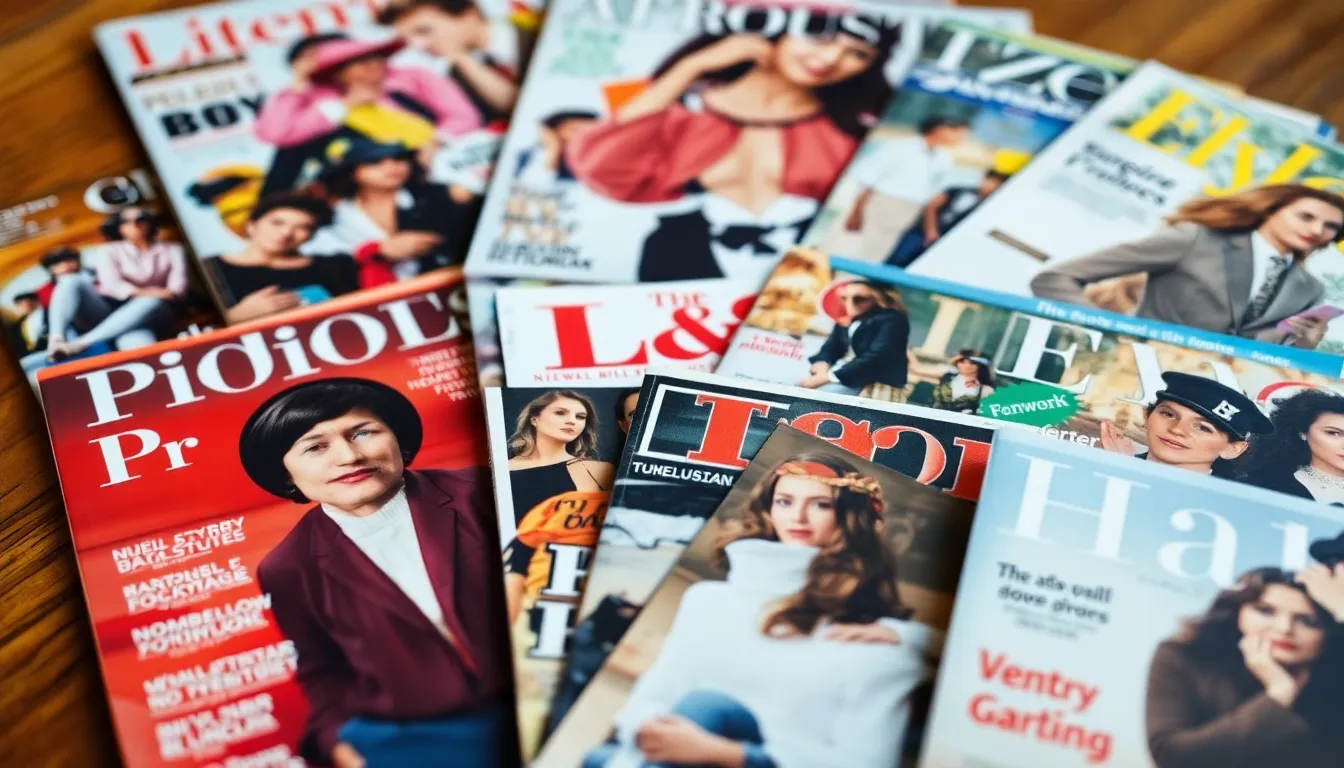Table of Contents
ToggleIn a world buzzing with digital distractions, magazines still hold a special place in the hearts of many. They’re like that cozy café where you sip your coffee, flip through glossy pages, and lose track of time. But what’s behind this enduring love affair? Magazine culture isn’t just about pretty pictures and celebrity gossip; it’s a mirror reflecting society’s quirks, trends, and sometimes, its bizarre obsessions.
As readers dive into these vibrant publications, they’re not just consuming content—they’re participating in a cultural phenomenon. From fashion to politics, magazines shape opinions and spark conversations, often with a side of humor. So grab your favorite issue, get comfy, and let’s unravel the fascinating world of magazine culture. It’s more than just reading; it’s an experience that keeps on giving.
Overview Of Magazine Culture Analysis
Magazine culture entails an intricate interplay between content, design, and reader engagement. This cultural phenomenon serves as a mirror reflecting societal norms, preferences, and discussions. Magazines don’t simply deliver information; they create a dialogue that influences public opinion across various spheres, including fashion, politics, and lifestyle.
Cultural analysis focuses on understanding how magazines craft narratives that resonate with their audience. Different genres target specific demographics. Fashion magazines might highlight trends, while political publications delve into current affairs. Each format customizes its presentation to evoke a response from readers.
Content structure plays a significant role in magazine culture. Layouts, typography, and visuals contribute to the overall experience. Readers attribute personality and sentiment to these elements as they encounter them on the page. Through visual storytelling, magazines engage audiences and foster loyalty.
Psychographics also impact reader engagement. Motivations and interests create distinct reader segments. Lifestyle choices shape magazine consumption, influencing what topics receive the most attention. This personalization tailors the magazine experience to individual preferences.
Changes in technology further affect magazine culture. Digital platforms now compete with traditional print. Although print holds nostalgic value for many, online formats offer immediacy and interactivity. Publishers adapt to these shifts by blending print and digital strategies, maintaining relevance in an evolving landscape.
Overall, magazine culture analysis delves into trends, reader engagement, and publishing formats. Each component fosters a unique connection, encouraging readers to participate in ongoing cultural dialogues. By understanding these aspects, one can appreciate the significance of magazines in shaping societal narratives.
Historical Background

Magazines have a rich history, evolving from simple pamphlets to influential cultural artifacts. Understanding this progression reveals how magazines shaped and reflected societal dynamics.
Evolution Of Magazines
Origins trace back to the early 18th century with publications like The Gentleman’s Magazine. Initially, magazines provided a platform for literature and scholarly articles. By the 19th century, their content expanded, embracing diverse subjects such as fashion, politics, and social issues. Titles like Harper’s Bazaar and The Atlantic Monthly emerged, targeting specific demographics and interests. Changes in printing technology further propelled growth, making magazines more accessible. The 20th century introduced glossy layouts and color photography, transforming the visual appeal. Today, magazine genres cater to niche markets, underscoring diverse cultural interests.
Impact Of Technology
Technology significantly influenced magazine culture. Digital platforms revolutionized distribution, enabling instantaneous access to content. Several publishers adapted by launching online versions, increasing readership and engagement. Social media integration allowed for real-time feedback, enhancing interaction with audiences. Traditional print maintains a loyal following, but digital formats offered immediacy and multimedia experiences. The shift to online consumption necessitated a blended approach, with many magazines utilizing both mediums to reach wider audiences. Advertisers also adjusted strategies to favor digital analytics, demonstrating the ongoing evolution of magazine culture in a technology-driven environment.
Key Trends In Magazine Culture
Magazines continue to adapt to modern readership, reflecting dynamic cultural shifts. Emerging trends illustrate the profound impact of digital transformation and shifting audience engagement on magazine culture.
Digital Transformation
Print magazines experience significant changes due to the rise of digital platforms. Publishers utilize online spaces to reach broader audiences, creating websites and apps that cater to diverse interests. Multimedia integration enhances storytelling, allowing readers to engage with interactive content. Social media channels further amplify magazine reach, enabling immediate feedback and fostering community discussion. The balance between print and digital formats evolves, prompting traditional magazines to adopt hybrid models that merge tactile elements with online accessibility.
Shifts In Audience Engagement
Audience engagement transforms with the advent of social media and direct communication channels. Readers no longer passively consume content; they actively participate by sharing opinions and creating content. This shift encourages magazines to foster loyalty by cultivating a sense of community among readers. Unique experiences, like exclusive events and personalized content, bridge the gap between print and digital platforms. Data-driven strategies become essential for understanding preferences, helping publishers tailor content that resonates with specific demographics.
Major Themes In Magazine Content
Magazines reflect diverse themes that resonate with readers. Examining these themes reveals deeper connections within society.
Representation And Diversity
Representation and diversity are pivotal in shaping modern magazine content. Magazines increasingly spotlight marginalized voices and perspectives, showcasing a range of backgrounds and experiences. Publications now include stories from various ethnicities, genders, and orientations, providing a platform for underrepresented communities. This shift promotes inclusivity, encouraging readers to see themselves reflected in the narratives presented. Also, diversity in magazine imagery and language reflects evolving societal values, making content relatable to wider audiences. Engaging with diverse themes fosters community and broadens understanding among readers.
The Role Of Advertising
Advertising plays a crucial role in magazine culture, influencing both content and reader perception. Advertisements significantly impact magazine revenue, often dictating the type of content included. Brands partner with publications to target specific demographics, aligning their messages with the interests of readers. Notably, the integration of ads into editorial content creates a seamless experience, enhancing engagement. Additionally, trends show that lifestyle magazines often feature products that resonate with their audience, promoting a curated lifestyle. Through strategic advertising, magazines not only generate income but also shape consumer behavior, reinforcing their cultural significance.
Challenges Facing The Magazine Industry
The magazine industry faces multiple challenges as it navigates a rapidly changing landscape. Financial sustainability remains a pressing concern.
Financial Sustainability
Financial models are evolving. Traditional revenue streams, like print sales and advertising, struggle against decreasing circulation and digital competition. Publishers often rely on subscription models, requiring the creation of compelling content that retains readers. Data from the Magazine Publishers Association indicates that 73% of publishers report flat or declining revenue. Moreover, market saturation complicates finding unique selling propositions. Publishers must innovate by diversifying revenue through events or merchandise while optimizing content for younger audiences. Competing priorities among stakeholders add to the complexity, making financial sustainability an ongoing challenge.
Competition From New Media
New media platforms continuously disrupt magazine culture. Social media and online streaming services captivate audiences with instant access to information and entertainment. These digital spaces attract younger demographics, who prioritize immediacy over traditional print. Research by Pew Research Center shows that 55% of adults under 30 consume news primarily online. This shift necessitates that magazines adapt their strategies by embracing multimedia and interactivity to engage readers. Competing with digital giants means incorporating video content, interactive elements, and social media outreach into magazine offerings. As consumer preferences evolve, magazines must rise to the occasion or risk losing relevance in today’s media landscape.
Magazine culture remains a vital part of contemporary society despite the rapid rise of digital media. It serves as a platform for diverse voices and perspectives while fostering community and engagement among readers. By blending traditional print with innovative digital strategies, magazines continue to adapt to the evolving preferences of their audiences.
The challenges facing the industry are significant but not insurmountable. As publishers embrace new technologies and prioritize inclusivity, they can strengthen their cultural relevance. Ultimately, magazines will keep shaping conversations and reflecting societal values, ensuring their place in the media landscape for years to come.






